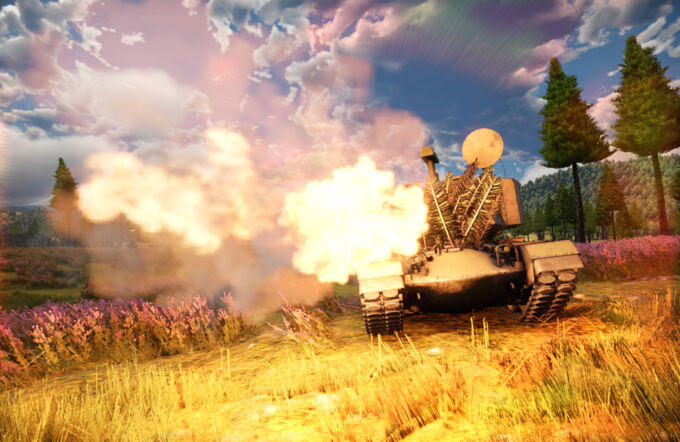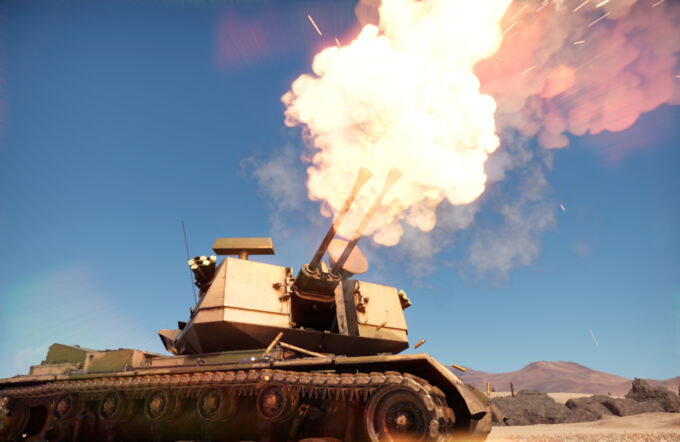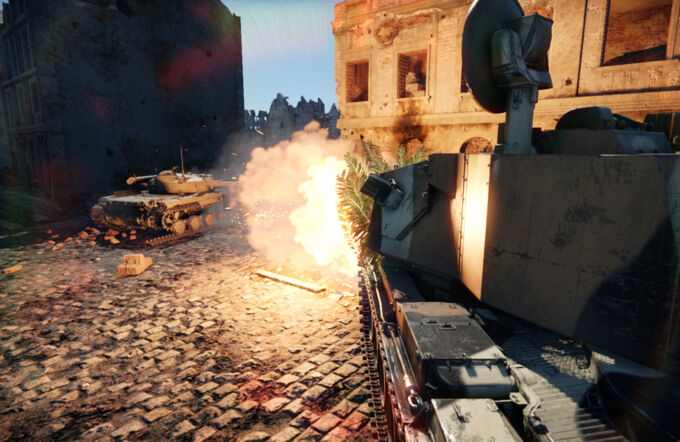The M247 is a SPAAG in the US tech tree at Rank VI and is arguably one of the best anti-air vehicles within its BR range. With devastating firepower and good electronics, it is the nightmare of all CAS pilots. However, this power comes at the cost of poor mobility, protection, and armour penetration, which makes it particularly vulnerable to enemy ground forces.
| Pros | Cons |
| Highly effective HE-VT shells | Poor armour and survivability |
| Shells don't have tracers, won't alert enemies | Below average mobility |
| Decent fire rate | HE-VT shells self-destruct at 4 km |
| Good radar | |
| Has laser rangefinder |
Mobility
Mobility definitely isn't the M247's strong suit. Being based on the M48 chassis, it has a 750 horsepower engine and a weight of 54.4 tons, meaning it has a below-average power-to-weight ratio of 13.8 hp/t. The maximum forward speed is also average at 48 km/h, although the reverse speed of 11 km/h is decent and allows it to back out of dangerous situations.
Armour and survivability
The M247, like most SPAAs, has fairly weak armour. The turret front has 25.4 mm of slightly sloped RHA, which is barely enough to block HMG bullets, while the turret sides and back only have 12.7 mm RHA, which will only stop rifle-calibre rounds. Hull armour isn't terrible as it is a M48 chassis, but enemies are most likely to go for the turret anyway. Survivability is also terrible. There are two large ammo racks at the very front of the turret, which means that any shots from the front are guaranteed to cause an ammo explosion, instantly destroying the vehicle, while a side shot to the turret will likely kill both of the tightly packed turret crew members.
Armament and electronics
This part is what makes the M247 one of the most feared SPAAGs at its BR. It is armed with two 40 mm M266 autocannons with a fire rate of 300 rounds per minute. Its primary round is the M822 HE-VT shell. With 190.8 g of TNT equivalent and a 7 m trigger radius, it will rapidly evaporate any aircraft that comes within range. However, it self-destructs at 4 km, which can be extremely frustrating if a helicopter is hovering just beyond this distance.
Because only one belt of the M822 can be taken, commanders can opt to take the M811 Fuze Delay shell as well. As a SAPHEI round with just 38 mm of penetration point blank, it struggles to defeat enemy MBTs even from the sides or back. However, the 262.35 g of TNT equivalent will guarantee a kill on penetration, making it devastating for enemy light vehicles.
The M247 also has a good radar suite. The M247 TA search radar has a search zone of 360˚x15˚ (X-ray view shows 360˚x8˚) and a maximum range of 45 km, which is more than enough for its BR. The AN/APG-66 track radar has a range of 15 km, although the search radar only cues it onto targets within 10 km. It has the additional benefit of confusing some enemies with RWR, as it is also the radar used on the F-16. It also has a laser rangefinder which is useful for firing upon distant ground targets, especially since none of the M247's shells have tracers.
Usage in battle
As one of the best SPAAs at its BR, the M247 is pretty easy to use: find a good position to wait for enemy aircraft, lock on, and open fire. But let's go into a bit more detail:
Positioning
Since most maps at the BR are relatively small, the M247 can cover the whole battlefield from any point on the map. Therefore, the chief concerns for positioning are concealment from enemy ground vehicles and line of sight to enemy aircraft and helicopter spawn points. Small, gently sloped hills are good for hiding behind while providing a clear view of the sky.
Locking on
While the search radar has enough range to detect enemy aircraft as soon as they spawn (if you adjust the radar scale to 20+ km), it only cues the tracking radar on target within 10 km. However, you shouldn't wait until the enemy is that close before trying to lock on, because occasionally a smart enemy pilot will try to climb high, above the maximum elevation of the search radar, which makes finding them later much harder. Therefore, you should try to lock onto the enemy as soon as the spawn (aircraft spawn points are generally within 15 km of the battlefield) by pointing the tracking radar in the direction of the search radar contact and manually pressing the lock button several times at different angles until a lock is acquired.
Firing
While the fire control system provides a lead point for the guns, you shouldn't trust it too much. It calculates the lead as if the plane is flying at a constant speed and direction, which is rarely the case in reality, so you will need to compensate for these changes. If the lead is growing, the enemy is accelerating and hence you need to lead it a bit more, and vice versa if the lead is shrinking. If the enemy is turning, aim slightly ahead of the turn. With practice, the M247 can shoot down any aircraft within 3 km regardless of how violently they are manoeuvring. Additionally, when firing at helicopters hovering close to the HE-VT's maximum range, you can wriggle your aim to scatter the shots around the enemy to ensure a better probability of kill.
Dealing with enemy ground forces
Ideally, you shouldn't have to worry about this, having chosen a location that is concealed from the enemy and far from the front lines. However, on some maps such a location might not exist, or your team has collapsed and the enemy is pushing into your spawn. The M811 Fuze Delay is only effective against light vehicles, so if an MBT comes bearing down on you, your best option is to break their tracks and barrel and run, although once in a blue moon the M811 might overpressure the enemy in some weird location.
Dealing with guided weapons
In uptiers, the M247 can see some early fire-and-forget AGMs. Fortunately, most of these weapons are of fairly short range and bring the carrier aircraft close to your firing range. Additionally, the M247 radar is capable of detecting and locking onto such munitions, and the HE-VT will make quick work of them.





